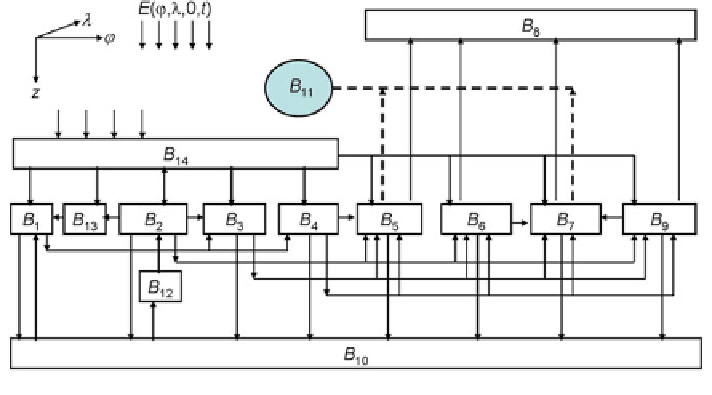Geoscience Reference
In-Depth Information
10
8
kg/year. From the
available data, anchovy constitutes above 95 % of the catch, and therefore the
derivation of the model of the functioning of the Peruvian ecosystem is also
important for the economy of the bordering states. Of course, the real limits of the
interaction of the natural-anthropogenic system of the concrete state of South
America with the global environment are impossible to assess without taking into
account the role of the ecosystem of the Peruvian Current.
The Peruvian Current refers to the regions of the World Ocean where compli-
cated interconnected and interdependent physical, biological, and chemical pro-
cesses take place on a relatively small area. Near the coastlines of Peru and Chili the
production of organic substance is so large that the available oxygen is not enough
for it to be oxidized, and as a result, a layer with an oxygen de
anchovy whose average production is estimated at 100
×
cit appears at depths
100
800 m. This is accompanied by underfeeding of fauna.
In the hierarchic structure of the trophic relationships of the Peruvian Current
community, the following components can be selected (Fig.
4.4
): B
1
—
-
bacterio-
plankton;B
2
—
phytoplankton; B
3
—
phytophag; B
4
—
predatory zooplankton; B
5
—
industrial anchovy; B
6
—
anchovy grubs; B
7
—
predatory
sh; B
9
—
anchovy young-
dissolved organic matter (cal/m
3
); B
8
—
birds (birds/m
2
);
sters; B
10
—
detritus; B
13
—
biogenic elements (mg/m
3
); B
14
—
B
12
—
'
'
); B
11
—
volume of
anchovy catch (t/km
2
). The characteristic feature of the trophic graph of the system
is the availability of connections between the components of the ocean biocenoses
(B
5
, B
7
, B
9
) and the land biocenoses (B
8
). An introduction of this connection into
the model has turned out to be essential, since the maritime birds (cormorants,
pelicans, etc.) in the regions of the Peruvian current markedly affect the dynamics of
the whole system. From the available estimates, anchovy constitutes from 80 to
96 % of the food spectrum for birds. Therefore the characteristic feature of the
developed model is an account of the element of interaction of the land and ocean
dissolved oxygen (m
/
Fig. 4.4 The block-scheme of the Peruvian Current ecosystem model (PCEM)

Search WWH ::

Custom Search